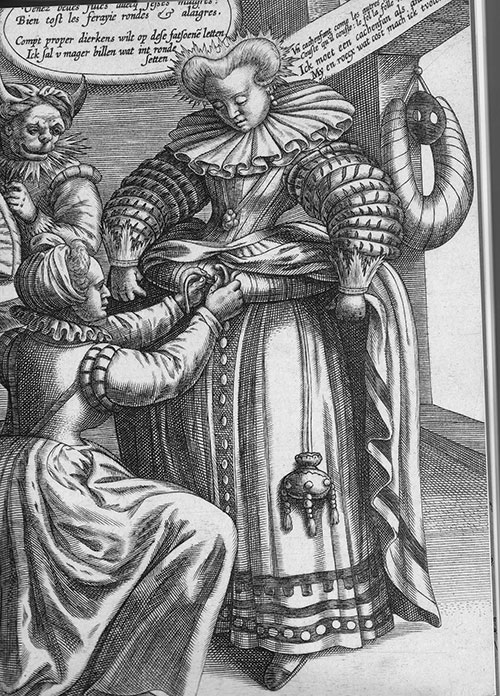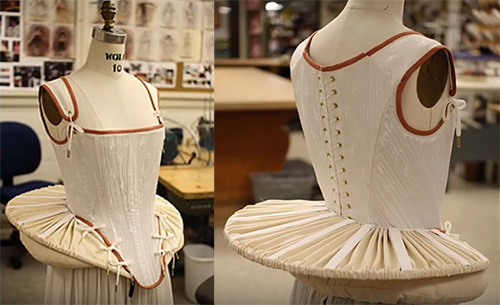 Unfortunately, we know about this underpinnings item only from old books, tailors' bills, and paintings that only give us a clue about this farthingale’s shape. There are no dozens of portraits and etchings, like with gowns, collars, gloves, corsets, and other vintage clothing articles, where we can see the item in all detail. But still, fashion historians, seamstresses, and museum workers have some info about this underwear piece popular in Europe in the 16th century. Let’s find out what we can about the wheel farthingale and look at its modern reproductions.
Unfortunately, we know about this underpinnings item only from old books, tailors' bills, and paintings that only give us a clue about this farthingale’s shape. There are no dozens of portraits and etchings, like with gowns, collars, gloves, corsets, and other vintage clothing articles, where we can see the item in all detail. But still, fashion historians, seamstresses, and museum workers have some info about this underwear piece popular in Europe in the 16th century. Let’s find out what we can about the wheel farthingale and look at its modern reproductions.
This underwear item is called “wheel farthingale” or “French farthingale”. It is a rigid structure used by women in the 16th century to support the skirt and create a certain silhouette. This structure creates a round horizontal “shelf” at the waist so that the skirt is draped wider at the woman’s hips.
This underpinning piece is always rigid. So, how did they achieve this? According to the wardrobe accounts and tailors' bills from the late 16th century that have survived to our day, the materials used to make French farthingales were whalebone, buckeram fabric, and starched cloth. These farthingales were often sewn from buckeram fabric (special stiff cloth), stuffed with cotton and rags, they had hoops of whalebone or bent reeds or wire to stiffen the construction, or the fabric was starched to achieve the needed rigidness.
Sadly, we don’t have any existing examples of wheel farthingales or even drawings that show how it looked like. There is only one illustration (and even this one doesn’t depict the wheel farthingale itself) – a satirical Dutch engraving from around 1600 that shows the bum roll of a wheel farthingale being affixed by a tiring-woman. Here is the link to a source.

All we have is paintings depicting fully dressed women with this particular silhouette (we can decipher the wheel farthingale’s shape under the skirt but don’t see the undergarment itself) and mentions of a French farthingale in texts. So, actually, all of the modern reproductions of a wheel farthingale are just an educated guess. They are based on our knowledge about the 16th-century sewing techniques and the materials we know for sure were used to make this underwear piece. Still, most probably, that’s how a wheel farthingale looked like in reality.

Queen Elizabeth I by Nicholas Hilliard, circa 1599. The portrait is stored in Hardwick Hall, Derbyshire, the UK. Underneath the dress, she’s probably wearing a wheel farthingale
For instance, here is a nice reproduction. It was made by costume technician Danielle Jordan for the TV series “Reign”. We can see a corset, a rigid wheel farthingale, and a bum roll that supports the farthingale.

Some fashion historians and costumers consider a wheel farthingale to be the same as drum farthingale and great farthingale, others divide these two garments. They definitely look similar and the last two probably derive from a wheel farthingale.


